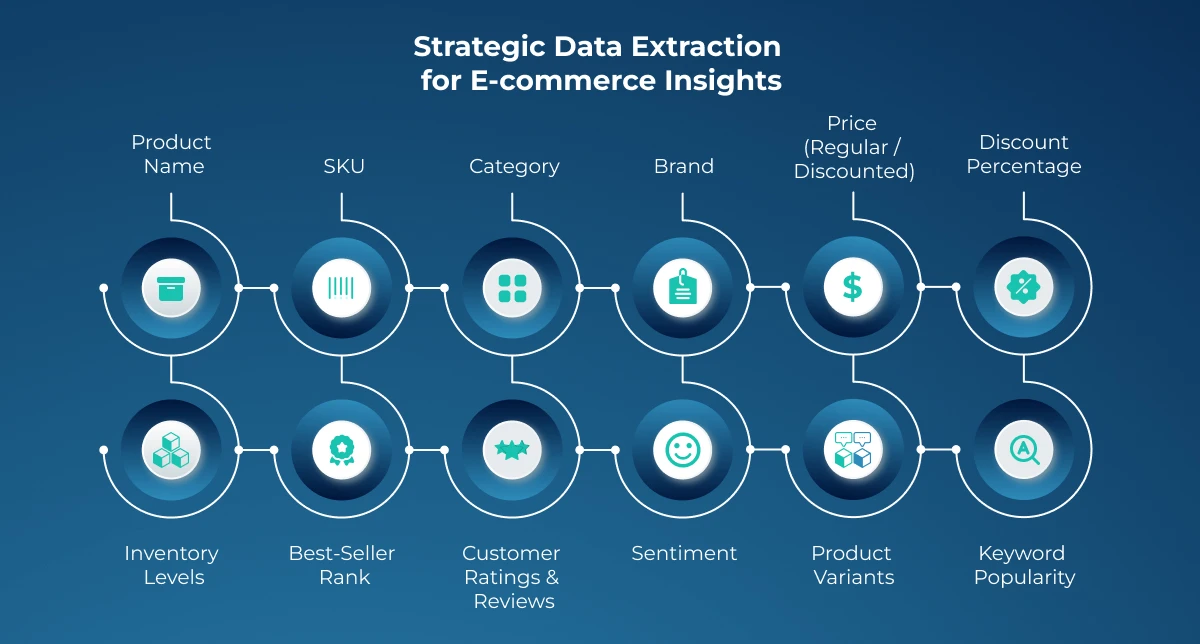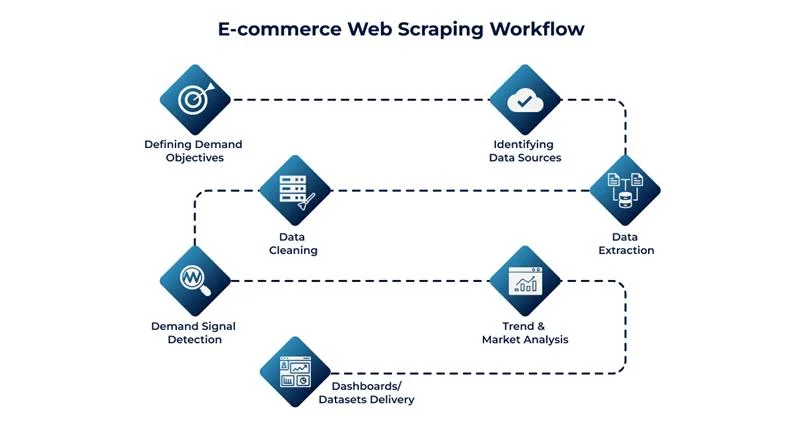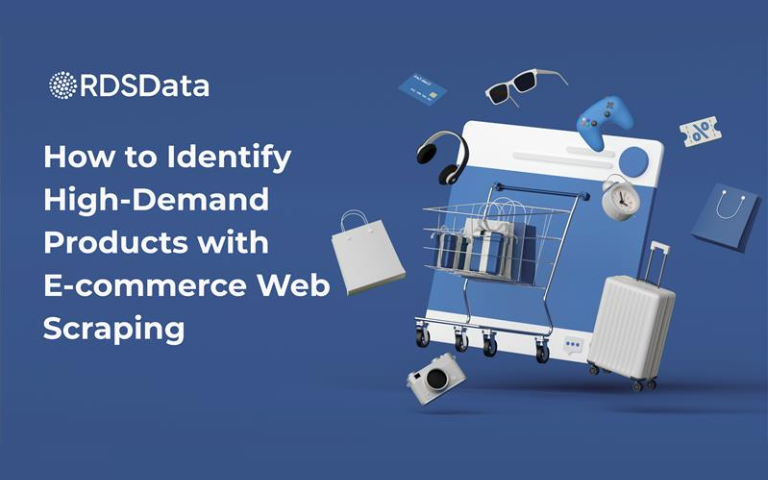Identifying high-demand products is one of the most critical decisions for any business operating in the digital commerce ecosystem. Companies often fail not because of a poor product idea, but because they misjudge market demand.
With e-commerce growing at a CAGR of about 14–15% globally over the coming years, the need for data-driven decision-making has never been more urgent.
According to Grand View Research, the global e-commerce market was valued at around $25.93 trillion in 2023, and is projected to reach $83 trillion by 2030.
Traditional methods like surveys, focus groups, or manual competitor analysis are slow and often inaccurate. For executives who need actionable insights, understanding real-time product performance across multiple marketplaces is essential.
Here, web scraping and structured data extraction provide the means to gather product prices, reviews, inventory trends, and more at scale.
Understanding Market Demand in E-commerce
What is Market Demand?
Market demand represents the consumer need or desire for a product, backed by purchasing power. In e-commerce, this can be quantified by:
- Sales volume trends: Number of units sold per day/week/month.
- Search trends: Keyword searches on platforms like Amazon, Google Shopping, or Shopify stores.
- Customer engagement: Reviews, ratings, and social mentions.
Why Accurate Demand Insights Matter
Accurate insights allow companies to:
- Optimize inventory levels, reducing overstocking or stockouts.
- Decide pricing strategies dynamically using competitor pricing trends.
- Launch products in growing categories before market saturation occurs.
- Mitigate investment risk by targeting high-potential SKUs.
Limitations of Traditional Market Research
- Manual competitor tracking: Inefficient and prone to human error.
- Surveys and focus groups: Often biased or outdated by the time results arrive.
- Limited data sources: Cannot scale across thousands of SKUs or marketplaces.
This is where web scraping e-commerce websites comes into play, providing structured, real-time, and actionable data.
Web Scraping as a Tool for Product Research
What is E-commerce Web Scraping?

Web scraping is the process of programmatically extracting data from websites. In e-commerce, it involves collecting:
- Product details: Name, SKU, description
- Prices: Including discounts and regional variations
- Reviews and ratings: Customer sentiment insights
- Inventory availability: Stock levels and restock frequency
It is important to respect the terms of service for each site. Parsing HTML, scraper APIs, and Python libraries like BeautifulSoup or Scrapy are often used to automate data extraction.
Types of Data Extracted
- Structured data: Product titles, SKUs, price, stock
- Semi-structured data: Reviews, Q&A sections, image URLs
- Unstructured data: Social comments, blog mentions, product comparisons
These data types help in trend prediction, competitor analysis, and market segmentation.
Benefits Over Traditional Methods
- Scale: Monitor thousands of SKUs across multiple commerce sites.
- Accuracy: Capture real-time prices, stock, and ratings.
- Automation: Scheduled scraping reduces human workload.
- Cross-market insights: Compare products across regions, marketplaces, and competitors.
How to Identify High-Demand Products Using Data
Defining “High Demand” for Your Business
High demand is relative and depends on metrics such as:
- Sales velocity: How fast a product sells in a given period.
- Price elasticity: Products that maintain sales despite price changes.
- Customer engagement: High ratings, frequent reviews, and wishlist additions.
- Competitor saturation: Products with high demand but moderate competition are ideal targets.
A typical method is to monitor daily sales ranks on Amazon or trending SKUs on Shopify, then analyze historical trends over 3–6 months.
Key Data Sources for Web Scraping
- E-commerce platforms: Amazon, eBay, Walmart, Shopify stores
- Competitor websites: Direct product pricing and availability
- Social media channels: Instagram, TikTok, and Pinterest trends
- Review aggregators: Customer sentiment metrics
- Search engines: Keyword popularity and seasonality
Each source contributes to specific data extraction, providing a holistic view of demand.
Analyzing Trends and Patterns
After scraping, data parsing is crucial. Key techniques include:
- Time-series analysis: Track SKU demand over months.
- Sentiment scoring: Using NLP on reviews to gauge product perception.
- Price trend analysis: Understanding seasonal or competitor-driven price shifts.
- Correlation analysis: Identify which products move together or trigger cross-selling.
Predicting Product Demand
- Historical demand patterns + trend extrapolation
- Seasonality adjustments: Peak periods like Black Friday or festive seasons
- Competitor analysis: Track SKUs with sudden popularity spikes
- Predictive modeling: Using Python libraries and structured data for machine learning forecasts
E-commerce Web Scraping Process for Identifying High-Demand Products

Step 1: Define Demand Objectives
We start by aligning with business goals, clarifying KPIs like sales velocity, competitor benchmarking, or regional insights to ensure demand analysis drives strategic outcomes.
Step 2: Identify Data Sources
E-commerce platforms, competitor listings, reviews, pricing, and marketplace categories are mapped to define structured, high-volume data streams relevant to product demand discovery.
Step 3: Data Extraction Framework
Enterprise-grade scraping pipelines automate large-scale extraction, ensuring consistency, accuracy, and compliance with site structures for seamless demand intelligence at scale.
Step 4: Data Cleaning & Structuring
Raw data is standardized, deduplicated, and normalized into usable formats, transforming unstructured product and pricing data into structured demand-ready datasets.
Step 5: Demand Signal Detection
Advanced models filter indicators like stockouts, review spikes, bestseller ranks, and pricing fluctuations to signal which products carry high-demand potential.
Step 6: Trend & Market Analysis
Temporal patterns, seasonal demand, and geographic variations are analyzed to forecast growth opportunities and validate demand drivers across multiple categories.
Step 7: Strategic Insights Delivery
Insights are delivered as dashboards or custom datasets, enabling executives to compare, prioritize, and act on high-demand product opportunities with confidence.
Data Collection & Technical Setup
Choosing the Right Scraping Framework
Enterprise scraping requires robust frameworks like Scrapy, BeautifulSoup, or Selenium. For large-scale operations, API-driven extraction ensures efficiency, scalability, and integration, avoiding DIY complexities that hinder enterprise data strategies.
Handling Large-Scale Data Extraction
High-demand product research demands distributed scraping architectures, cloud-based pipelines, and concurrency controls. Scalable systems handle millions of SKUs across regions, ensuring reliable enterprise-grade insights without compromising speed or accuracy.
Ensuring Data Quality & Accuracy
Enterprise decisions depend on clean, validated, and deduplicated datasets. Error handling, schema validation, and quality assurance pipelines ensure structured data accuracy that business leaders can fully trust for strategic decision-making.
Legal Compliance and Terms of Service
Responsible data collection means adhering to legal frameworks, respecting site terms, and following compliance protocols. Enterprise providers implement safeguards, ensuring long-term sustainability without exposing organizations to unnecessary regulatory or legal risks.
Strategic Use Cases by Industry
Retail & CPG
Retail and CPG firms leverage scraped marketplace, SKU, and shelf-level data to optimize assortments, track competitor launches, and align demand forecasting with evolving consumer preferences.
Electronics & Tech Insights
Web scraping extracts product reviews, specifications, and pricing movements across tech platforms, enabling electronics companies to prioritize innovation, optimize launch strategies, and predict high-demand accessories.
Automotive & Accessories Optimization
Data extraction identifies trending automotive parts, accessory demand cycles, and marketplace gaps, supporting manufacturers, distributors, and retailers in product positioning, pricing optimization, and supply chain agility.
Health, Fitness, and Wellness Trends
Scraped fitness equipment, supplements, and wearables data highlight consumer shifts, enabling businesses to design targeted product portfolios, enhance market positioning, and forecast category expansion opportunities.
Food & Beverage Product Launch Insights
Data-driven insights from recipes, consumer reviews, and product listings guide F&B brands in validating demand, tracking competitor launches, and reducing risks in new product introductions.
Making Strategic Decisions Based on Scraped Data
Executives can leverage insights for:
- Product launches in high-demand categories
- Dynamic pricing and promotions
- Inventory allocation across regions
- Product bundling strategies based on correlated demand
- Identifying opportunities for new market entry
How RDS Data Can Help
Looking to identify high-demand products faster? At RDS Data, we provide end-to-end web scraping services for e-commerce businesses, from product data extraction to structured insights.
Let our expertise help you track trends, monitor competitors, and make smarter, data-driven decisions. Get in touch with our data consultants today!
Conclusion
Web scraping allows businesses to identify high-demand products accurately, reduce market entry risk, and stay competitive. With proper structured data extraction, sentiment analysis, and predictive modeling, executives gain the insight needed to make informed, timely decisions.
FAQs
Tired of broken scrapers and messy data?
Let us handle the complexity while you focus on insights.

